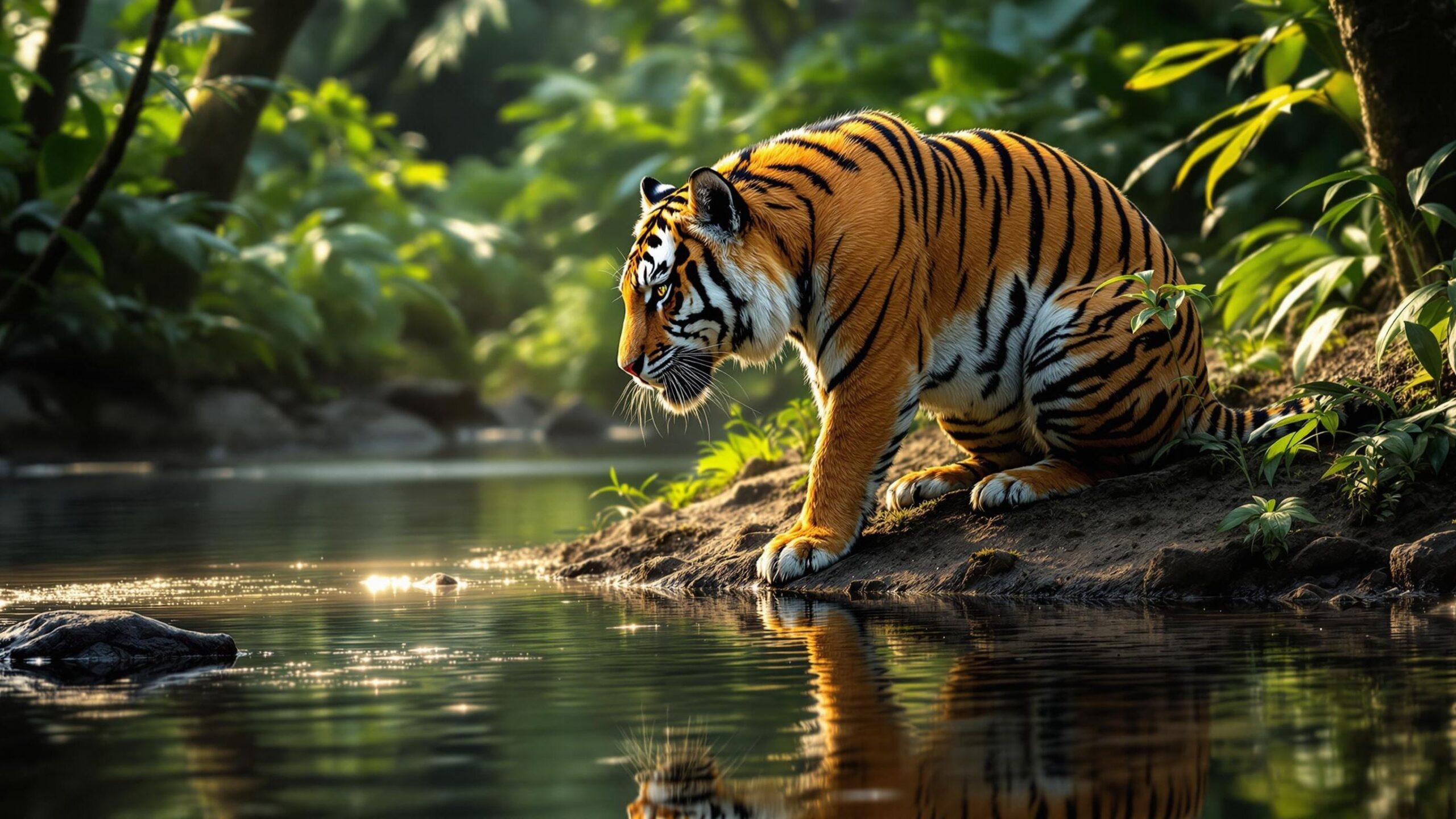Sumatran Tiger: The Striped Shadow of the Rainforest
Deep in the emerald rainforests of Sumatra, where mist drapes the treetops and the air thrums with life, prowls a creature both beautiful and elusive—the Sumatran tiger (Panthera tigris sumatrae). This remarkable feline, the smallest surviving subspecies of tiger, is a living embodiment of mystery, power, and vulnerability. Found only on the Indonesian island of Sumatra, it is a symbol of both natural wonder and ecological fragility. As the last remaining island tiger in Indonesia, the Sumatran tiger stands apart, shaped by the dense forests, swamps, and rugged terrain it calls home. This article explores the fascinating world of the Sumatran tiger, from its unique physical traits and behaviors to its historical and cultural significance. Along the way, we’ll uncover how this extraordinary animal has adapted to life in one of the planet’s richest, yet most threatened, ecosystems.
A Tiger Apart: Unique Characteristics of Panthera tigris sumatrae
The Sumatran tiger is immediately distinguishable from its mainland cousins. Smaller and more compact, it has evolved to navigate the thick undergrowth of tropical jungles with agility and stealth. Males typically weigh between 220 and 310 pounds (100–140 kg), while females are noticeably lighter, averaging between 165 and 243 pounds (75–110 kg). Their body length ranges from 7 to 8 feet, including the tail, which serves as a counterbalance during fast, agile movement through dense vegetation.
One of the most striking features of the Sumatran tiger is its coat. The fur is a deep, burnt orange with bold black stripes that are closer together and more numerous than those on other tiger subspecies. These dense stripes help it blend seamlessly into the rainforest shadows. Many Sumatran tigers also exhibit a mane-like ruff of fur around the neck, especially in males, lending them a regal, lion-like appearance. Another notable trait is the tiger’s unusually webbed feet. Though subtle, this adaptation is believed to aid in swimming—a useful skill in Sumatra’s swampy lowlands and riverine forests.
Life in the Shadows: Habitat and Distribution
Sumatran tigers are found exclusively on the island of Sumatra, the sixth-largest island in the world and a region of exceptional biodiversity. The tigers inhabit a range of forest types, including lowland rainforests, freshwater swamp forests, and montane forests up to elevations of 10,000 feet (3,000 meters). These diverse habitats are rich in prey species and offer the thick cover needed for stealthy hunting.
However, the Sumatran tiger’s range is fragmented, limited to isolated patches of forest across the island. The largest populations are concentrated in protected areas such as Gunung Leuser National Park, Kerinci Seblat National Park, and Bukit Barisan Selatan National Park—all part of the UNESCO-listed Tropical Rainforest Heritage of Sumatra. Even within these sanctuaries, tigers must navigate the challenges of encroaching human development, agricultural expansion, and illegal logging.
Master of the Hunt: Diet and Hunting Behavior
Like all big cats, the Sumatran tiger is a carnivore and an apex predator, relying on stealth, patience, and power to catch its prey. It typically hunts at night, using its keen senses of hearing and sight to track and ambush animals in the undergrowth. Unlike cheetahs, which chase down their prey in open terrain, tigers prefer the element of surprise, using their environment to get close before launching a sudden, explosive attack.
The Sumatran tiger’s diet is varied and opportunistic. It preys on a range of animals, including deer (such as sambar and muntjac), wild boar, tapirs, and even smaller animals like monkeys and birds if larger prey is scarce. Occasionally, it may also take livestock from nearby villages, which can bring it into conflict with local communities. Tigers typically kill by biting the neck or throat of their prey, severing the spinal cord or suffocating the animal. They may eat up to 88 pounds (40 kilograms) of meat in one sitting, then spend several days resting while digesting their meal. Despite their formidable hunting skills, they often face competition from humans, habitat changes, and diminishing prey availability.

Solitary Wanderers: Social Behavior and Territory
Sumatran tigers are solitary creatures, each occupying a territory that is marked and fiercely defended, particularly by males. A male’s territory can overlap with those of several females, but it typically won’t tolerate other adult males within its domain. Tigers mark their territory using scent markings, scratch marks on trees, and vocalizations like roars or chuffing sounds.
Females raise cubs alone, usually giving birth to litters of two to four cubs after a gestation period of around 100 days. Cubs are born blind and helpless, relying entirely on their mother for protection and nourishment. The mother nurses them for up to six months and teaches them how to hunt over the next year or two. Cubs generally stay with their mother until they’re about two years old, after which they leave to establish their own territories. Interactions between tigers are rare, except during mating season or when a female is raising her young. Mating is brief and infrequent, with long intervals between births due to the challenges of rearing cubs in such a competitive and often dangerous environment.
Island of Legends: Cultural Significance
The Sumatran tiger holds a significant place in local folklore and mythology. In many Sumatran communities, tigers are seen as spiritual beings or guardians of the forest. Some believe that ancestral spirits can take the form of tigers, watching over the land and protecting the balance of nature. These beliefs have historically afforded the tiger a kind of sacred status, offering some protection from hunting.
However, the modern world has tested these traditions. While respect for tigers remains in some rural areas, others see the animals as threats to livestock or as valuable trophies. The rise of poaching, driven by demand for tiger parts in traditional medicine and black-market trade, has greatly endangered the subspecies despite its cultural roots.
A Fight for Survival: Conservation Status
The Sumatran tiger is classified as Critically Endangered on the International Union for Conservation of Nature (IUCN) Red List. Fewer than 400 individuals are believed to remain in the wild, and the number continues to decline due to habitat loss, poaching, and human-wildlife conflict. Sumatra has lost more than half of its natural forest cover in the past 40 years, primarily to palm oil plantations, logging, and agricultural encroachment. This deforestation not only reduces the tiger’s habitat but also fragments it, making it harder for individuals to find mates, maintain genetic diversity, and access sufficient prey.
Conservation efforts are ongoing and multifaceted. Key initiatives include the establishment and management of protected areas, anti-poaching patrols, community education programs, and law enforcement to combat illegal wildlife trade. Organizations like the World Wildlife Fund (WWF), Panthera, and Indonesia’s Ministry of Environment and Forestry play leading roles in these campaigns. There are also innovative strategies being explored, including wildlife corridors that link fragmented habitats, advanced camera trap monitoring, and even the use of scent-detection dogs to track poachers. Captive breeding programs, while controversial, offer a potential insurance policy against extinction, though the ultimate goal remains preserving and restoring wild populations in their natural habitats.

A Species on the Brink—but Not Yet Lost
Despite the challenges, the Sumatran tiger is not beyond hope. Stories of successful births in the wild, territorial expansion into newly protected areas, and declining poaching rates in some regions offer glimmers of optimism. The tiger’s resilience is nothing short of remarkable—it has endured volcanic eruptions, rising seas, and Ice Age isolation. Its continued existence is proof of nature’s ability to adapt and survive.
However, its future depends on us. The survival of the Sumatran tiger hinges on responsible stewardship of forests, sustainable development practices, and global awareness. Every step toward conservation—no matter how small—contributes to a broader movement to safeguard one of the world’s most captivating big cats.
A Final Glance: Why the Sumatran Tiger Matters
Tigers have always captured the human imagination. They represent strength, mystery, and wildness in its purest form. The Sumatran tiger, cloaked in the rain-soaked shadows of an island jungle, is more than just a subspecies—it is a living thread in the intricate web of biodiversity. Its survival ensures the health of entire ecosystems, from the smallest insects to the towering trees that form the rainforest canopy.
Protecting the Sumatran tiger is not just about saving a single species. It is about preserving the ancient rhythms of nature, honoring the legacy of a unique animal that evolved in isolation, and leaving behind a world where future generations can still marvel at the raw beauty of a tiger in the wild. In the end, the Sumatran tiger reminds us of something profoundly simple: that the world is a richer, more magical place with wild things in it. And among those wild things, few are as majestic—or as imperiled—as the tiger of Sumatra.

